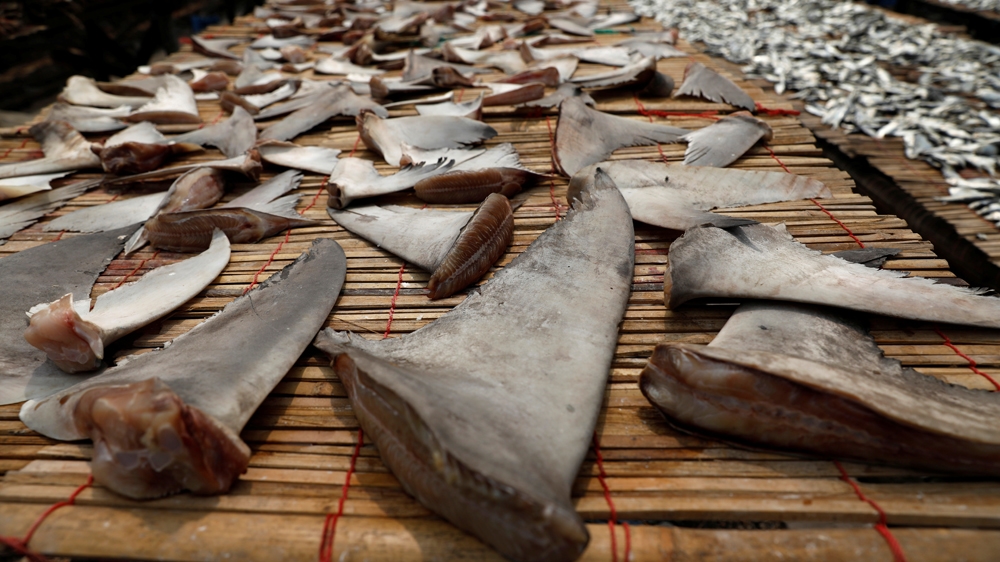
Humans kill an estimated 100 million sharks annually and experts have warned that certain species face extinction if the trend continues.
Consumption of shark fin soup, primarily in China and Vietnam, is the biggest reason behind the massive figure, contributing directly to the killing of almost half of the sharks, according to reports.
The soup was historically limited to banquets and weddings hosted by the elite in China but the economic boom in the country made it accessible to a wider public, resulting in its consumption doubling between 1985 and 2001.
To meet the rise in demand, shark hunting increased drastically, with most hunters throwing the shark back in the water after chopping off its fin.
“Shark meat tends to be of low value but shark fin soup is what’s driving the industry and became the single biggest reason behind such huge figure,” Mark Meekan, marine biologist at the Australian Institute of Marine Science, told Al Jazeera.
“Sharks don’t have the biology to sustain high levels of fishing. They grow slow, have relatively few young ones and take a long time to mature. If you fish them hard, the population collapses.”
 |
| Consumption of shark fin soup doubled in China between 1985 and 2001 [Chaiwat Subprasom/Reuters] |
Hong Kong is the main port of entry for about half of all globally traded dried shark fins, according to Yvonne Sadovy from the Swire Institute of Marine Science.
Almost 33 percent of the shark fins for sale in Hong Kong were from species listed as Threatened by the International Union for Conservation of Nature.
Taking notice
The depleting shark numbers and pressure by marine life activists have, however, forced people to take notice.
The Chinese government has now banned shark fin soup at state banquets and Air China forbids transport of shark fins on its airplanes.
More than 20 countries placed bans or restrictions on shark finning. The list includes the United States, whose president Donald Trump reportedly had shark fin soup at a state dinner in Vietnam last year.
According to WildAID, shark fin consumption in China has reduced by 50 to 70 percent since 2011. The China Seafood Logistic and Processing Association reported shark fin imports decreased by 81 percent from 2011 to 2014.
Earlier this month, Hong Kong’s largest restaurant group Maxim’s announced it would stop serving shark fin from January 2020.
In India, shipment totaling eight tonnes of shark fin was confiscated en route to China and Hong Kong this month. The shipments were worth more than $6.2m and authorities estimated between 15,000 and 16,000 sharks were killed for it.
 |
| Hunters chop off the fins before throwing the shark back in the water [Beawiharta/Reuters] |
Despite intervention by various governments, sharks are being killed at a higher rate than what its population grows at.
A report in Marine Policy revealed that global shark catch has more than doubled to 1.4 million tonnes in the last six decades, threatening almost 60 percent of shark species.
“Sawfish, a very distinctive species of ray, used to be abundant throughout the world’s oceans. Now, in Central America, they can no longer fulfill their ecological function and are teetering on the verge of extinction,” said Rachel Graham, founder of the NGO MarAlliance.
“These animals maintain the health of rivers and coasts and now only exist in few pockets around the world.
If you take out a top-order predator, you have a population explosion for other species
Mark Meekan
“The problem is that anybody can put a net out. That is what has led to the demise of so many sharks and rays. Not all are potential targets. Some are by-catch as well. But if we get rid of, or at least restrict, the use of nets, we can reverse the downward trend.”
Nets, added Graham, was the main fishing gear that was leading to the extinct and threatened status for nearly a quarter of all sharks and rays.
Meanwhile, Meekan said that reduction in shark population will create an imbalance in the oceans.
“The top-order predators regulate the abundance and behaviour of species lower down the food chain. If you take that out, you have a population explosion for other species. You create all sorts of problems,” he said.
Effect on tourism revenue
In addition to marine life, the killings of these sharks are also affecting the tourism industry.
According to Graham from MarAlliance, almost 600,000 people went out looking for sharks as a form of tourism in 2013, generating more than $314m in revenue.
“The study’s scientists projected that revenue was expected to double in the next two decades,” said Graham. “But it can only double if people have something to see. Some species of sharks and rays have a reproduction pause of up to five years.
“We need live sharks and rays for healthy coasts, seas and fisheries, even if much of the world doesn’t realise it yet”
 |
| Shark-related tourism generated more than $314m in revenue in 2013 [Bobby Yip/Reuters] |
Nik Walsh, founder of the White Shark Diving Company in South Africa, remembers marine biologists talking about 10,000 to 15,000 great white sharks along the country’s shores in 1991. Now, they are estimated to be between 300 and 600.
“We have a huge problem on our hands,” said Walsh, who also runs a research institute to look into conservation and protection of sharks. “There’s no doubt that the decline is anything less than a disaster. I blame humans for it – over-fishing, nets and poachers.”
According to Walsh, the interest in shark tourism is still on a rise but with a declining population, it may affect tour operators across the world.
“In the long-run, companies will shut down if there are no sharks,” said Walsh. “No matter how good the trips are, if there are no shark sightings, you will get bad reviews. We have started giving free trips if a shark is not spotted on the tour.”
Conservation
Meekan reckons investing in shark conservation is a worthy move for governments that rely on shark tourism as a significant source of income.
In The Bahamas, he said, shark diving generated $800m over 20 years and raised the value of sharks as renewable resource compared with fishing. In Australia, the industry is estimated to bring in more than $25.5m annually.
Shark sanctuaries are being established on small island nations for protection and also encourage eco-tourism, direct spending on which amounts to more than $6bn a year now.
Shark tourism companies operate in more than 29 countries, including Fiji where 78 percent of all divers visiting the country in 2010 engaged in shark-diving activities. Direct taxes as a result of those activities fetched the government approximately $5.9m.
Tourists visiting the town of Gansbaai in South Africa, where Walsh’s business is based, to view the great white sharks make up more than half of local business sales
Despite the fall in population, Walsh is hopeful conservation efforts will bear fruit and the education tours will make people more informed.
“We are doing a hell of a lot despite the lack of funding and resources,” said Walsh. “We take classes in schools, raise funds for external conservation and research programmes and hope to have an eco-friendly barrier instead of nets along our coastline.
“I don’t know what the future holds but raising awareness is vital for the sustainability of any apex predator.”
 |
| Illegal fishing is also a big contributor to the decline in shark population around the world [Ismail Taxta/Reuters] |












